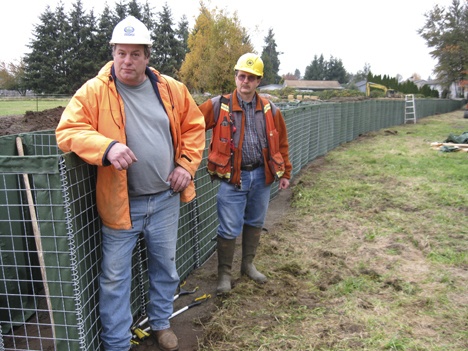The HESCO Barrier invasion has joined the fight against future flooding in Pacific.
Designed for the military, the HESCO Bastion USA (La.) Barriers are steel-framed caged sacks filled with sand. The barrier “cells” measure 3-by-3-by-4-feet tall, and linked they form a solid wall against floodwaters.
The City of Pacific hopes the temporary wall will protect its back yard from potential flooding.
The swollen White River unexpectedly swamped the city of roughly 6,000 last January, damaging more than 100 homes and 10 businesses and leaving $15 million in its wake.
This fall, the HESCO Bastion wall comes at a good time, spelling relief to wary residents and property owners.
“It will help, for sure,” said Mike Abernathy, whose family owns 15 acres of land along the river. “(Last January) was the first time I’ve ever seen (flood)water here.”
And hopefully, it will be the last time water seeps into city streets and neighborhoods.
Pacific Mayor Richard Hildreth is working with county and federal authorities to make sure the city is better prepared for floodwaters.
The U.S. Army Corps of Engineers is providing King County with HESCO barriers, which have been used successfully in flood-prone areas of the country. The barriers also are being deployed along stretches of the Green River in King County.
County crews have been busy the past two weeks building a temporary barrier along a three-quarters of a mile stretch along the river through the city. Work crews are placing roughly 4,000 linear feet of barriers along the river so that floodwaters can seep into Pacific City Park.
“Protecting people and their property is our No. 1 priority, and installing these advance flood-fighting measures in Pacific helps achieve our mission,” said King County Executive Kurt Triplett.
Federal money is aiding Pacific, as well as other valley cities, in the mitigation efforts.
Hildreth is encouraged by the collaborative effort to protect his city.
“There’s been an urgency,” he said. “There’s been lessons learned. By working together, we will accomplish more than working independently.”
Hildreth said the city is planning volunteer work parties to pack and place sandbags along the park’s perimeter.
Pacific was flooded last January by water released from the Corps’ Mud Mountain Dam on the White River.
The rate of release from the dam was not unusually large, but nonetheless it was damaging. Based on past water releases at a similar level, only minor flooding in non-residential areas of Pacific should have occurred.
According to an after-action report by the Corps, the apparent cause of the increased flooding was a substantial change in channel capacity. U.S. Geological Survey channel measurements at the river gauge location last January compared with those taken in November 2008 indicate an approximate 30-percent loss of channel capacity at the gauge location.
Hildreth hopes to establish a dredging maintenance program for the river. He estimated the channel hasn’t been scalped in about 20 years, and until the problem is addressed, it will remain a primary concern.
For now, the temporary measures can only help the city safeguard its residents and property.
“We were pushing for this,” Hildreth said of the barrier. “This comes from a lot of cooperation from the city, county and Corps.”


